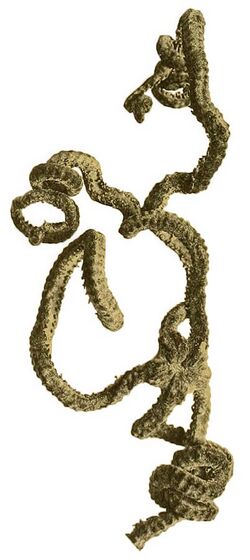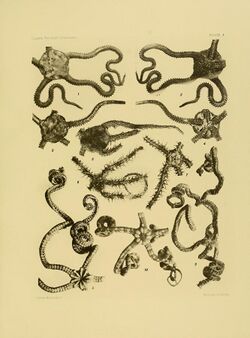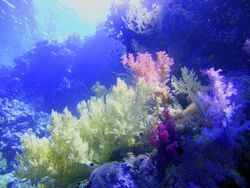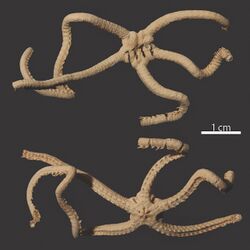Biology:Astrobrachion adhaerens
| Astrobrachion adhaerens | |
|---|---|

| |
| Scientific classification | |
| Kingdom: | |
| Phylum: | |
| Class: | Ophiuroidea
|
| Order: | Euryalida
|
| Suborder: | Euryalina
|
| Family: | |
| Genus: | Astrobrachion
|
| Species: | A. adhaerens
|
| Binomial name | |
| Astrobrachion adhaerens (Studer, 1884)[1]
| |
| Synonyms[1] | |
| |
Astrobrachion adhaerens is a basket star in the Euryalidae family. Along with A. constrictum, it is one of only two species in the genus Astrobrachion. Both species live in association with soft corals in moderately deep water. It is endemic to the west, north and east coasts of Australia, the Kermadec Islands and Lord Howe Island.[2]
Euryalids are the least well known Ophiuroids.[3] There is even lesser knowledge about A. adhaerens available. However it is closely related to its only sister species, A. constrictum, and information about this species and the family as a whole can provide insight into the anatomy, morphology, reproduction, and suspension feeding habits of A. adhaerens.[4]
Taxonomy
The taxonomy and phylogeny of species in the order Euryalida and class Ophiuroidea has been ambiguous and continues to be investigated.[5][6]
Euryalid fossils date back to strata as young as Cretaceous and Neogene. In the past, the ophiuroids were classified as either euryalids or non-euryalids due to stark morphological differences.[5]
Increased study in the areas of ophiuroid and euryalid historical morphology have revealed that Euryalids diverged from Ophiurids during the Triassic period, explaining why its ancestors shared some of the morphologies of the class Ophiuroidea.[5]
Distribution and Habitat
The genus Astrobrachion was first identified in New Zealand. Sister genera were identified in the Caribbean and Philippines .[7]
A. adhaerens is found in the tropical regions of Australia , ranging from Albany, Western Australia and the northern Australian coast to New South Wales, Lord Howe Island and the Kermadec Islands. The species is allopatric except at Lord Howe Island.[8]
Basket stars are found to reside on soft, cold water-corals such as the Nephtheidae soft corals at depths ranging from 25m to 1317m, especially on the Labrador, Newfoundland and Baffin Bay shelves. However low relative co-occurrence ranges (4%-54%) suggest that soft corals are not a necessary basket star habitat.[9]
Anatomy and Morphology
Basket stars have extensively branched arms made of a complex system of tissues and muscles. These arms are capable of regeneration, which is a characteristic that likely evolved as a response to frequent breaks of their long, thin, and fragile arms.[10]
Genera in Euryalida typically have thick skin and possess lateral arm plates but rarely have ventral arm plates or dorsal arm plates.[11] The genus Astrobrachion is set apart by having small ventral plates separated from the lateral arm by a supportive dermal tissue layer.[8]
The length of arm spines on Astrobrachion is the same length as the corresponding arm segment, like its sister genus Squamophis. These two genus, therefore, have the shortest spines in the Asteroschematidae family.[7]
A. adhaerens has longitudinal stripes while its sister species A. constrictum has transverse color banding on the arms. Both species vary from red to yellowish-white in color.[8]
Little is known of the reproductive system of A. adhaerens, but sexual characteristics are likely shared with closely related A. constrictum. A. constrictum are dioecious and exhibit no sexual dimorphism. They have a fused bursae and long, tubular gonads in the proximal half of their arms. Somewhat unique[clarification needed] to reproduction within species of the Asteroschematidae family is the structure of the germinal epithelium: folding over the testes in the male and concentric tapering of the germinal epithelium in the ovaries in the female.[4]
Behaviour
Very little of A. adhaerens behavior has been observed as their hard substrate, nocturnal activities and deep water habitat hinder the observation and collection of specimens.[3][4] A. adhaerens are suspension feeders that unfold their long, thin arms to feed at night.[5]
References
- ↑ 1.0 1.1 Stöhr, Sabine (2007). "Astrobrachion adhaerens (Studer, 1884)". World Ophiuroidea database. World Register of Marine Species. http://www.marinespecies.org/aphia.php?p=taxdetails&id=243145.
- ↑ O'Hara, Timothy; Byrne, Maria (2017). Australian Echinoderms: Biology, Ecology and Evolution. Csiro Publishing. p. 306. ISBN 978-1-4863-0763-0. https://books.google.com/books?id=EtkqDwAAQBAJ&pg=PA306.
- ↑ 3.0 3.1 Stewart, Brian (2005-05-11). "Anatomical features of the euryalid snake star Astrobrachion constrictum (Ophiuroidea: Asteroschematidae)". Invertebrate Biology 119 (2): 222–233. doi:10.1111/j.1744-7410.2000.tb00009.x. ISSN 1077-8306. http://dx.doi.org/10.1111/j.1744-7410.2000.tb00009.x.
- ↑ 4.0 4.1 4.2 Echinoderms through time : proceedings of the Eighth International Echinoderm Conference, Dijon, France, 6-10 September 1993. Bruno David. Rotterdam: A.A. Balkema. 1994. ISBN 90-5410-514-3. OCLC 32063437. https://www.worldcat.org/oclc/32063437.
- ↑ 5.0 5.1 5.2 5.3 Thuy, Ben; Stöhr, Sabine (2018-05-31). "Unravelling the origin of the basket stars and their allies (Echinodermata, Ophiuroidea, Euryalida)" (in en). Scientific Reports 8 (1): 8493. doi:10.1038/s41598-018-26877-5. ISSN 2045-2322. PMID 29855566.
- ↑ Okanishi, Masanori; O’Hara, Timothy D.; Fujita, Toshihiko (November 2011). "Molecular phylogeny of the order Euryalida (Echinodermata: Ophiuroidea), based on mitochondrial and nuclear ribosomal genes" (in en). Molecular Phylogenetics and Evolution 61 (2): 392–399. doi:10.1016/j.ympev.2011.07.003. PMID 21798356. https://linkinghub.elsevier.com/retrieve/pii/S1055790311003265.
- ↑ 7.0 7.1 Okanishi, Massanori; O'Hara, Timothy; Fujita, Toshihiko (2011-09-16). "A new genus Squamophis of Asteroschematidae (Echinodermata, Ophiuroidea, Euryalida) from Australia". ZooKeys (129): 1–15. doi:10.3897/zookeys.129.1202. ISSN 1313-2970. PMID 21998552.
- ↑ 8.0 8.1 8.2 Australian echinoderms : biology, ecology and evolution. Marie Byrne, Tim O'Hara, CSIRO. Clayton South, VIC. 2017. ISBN 978-1-4863-0763-0. OCLC 960042778. https://www.worldcat.org/oclc/960042778.
- ↑ Neves, Bárbara de Moura; Wareham Hayes, Vonda; Herder, Erin; Hedges, Kevin; Grant, Cindy; Archambault, Philippe (2020-10-09). "Cold-Water Soft Corals (Cnidaria: Nephtheidae) as Habitat for Juvenile Basket Stars (Echinodermata: Gorgonocephalidae)". Frontiers in Marine Science 7. doi:10.3389/fmars.2020.547896. ISSN 2296-7745.
- ↑ ""Morphogenesis and histogenesis during the arm regeneration in a basket star Astrocladus dofleini (Euryalida, Ophiuroidea, Echinodermata)" on Publons" (in en). https://publons.com/publon/32961340/.
- ↑ Okanishi, Masanori (2020). "Euryalida" (in en). Access Science. doi:10.1036/1097-8542.246500. https://www.accessscience.com/content/euryalida/246500.
External Links
Template:Echinoderm phylogeny Wikidata ☰ Q2219397 entry




